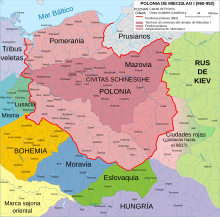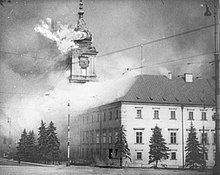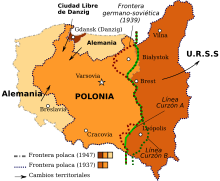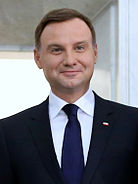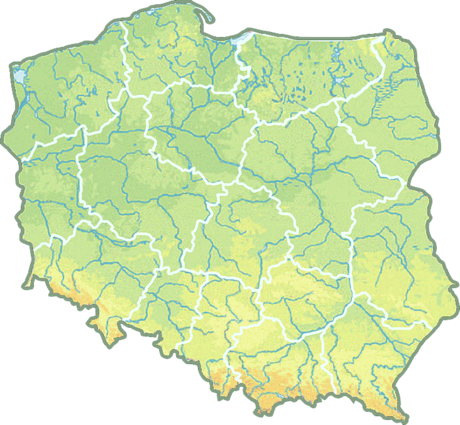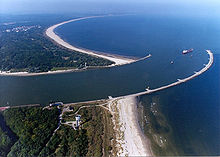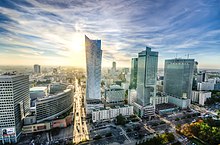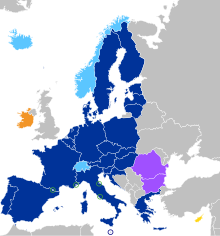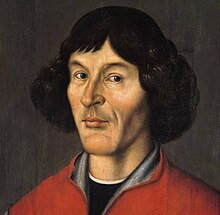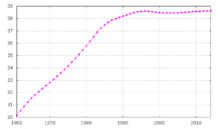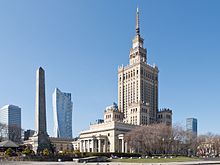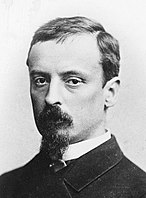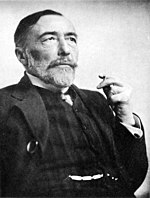Poland
Polandofficially the Republic of Poland (in Polish) ![]() Rzeczpospolita Polska (?·i)), is a country of Central Europe, one of the twenty-seven sovereign states that form the European Union, constituted in a democratic state of law and whose form of government is the parliamentary republic. Its territory, with capital in Warsaw, has an area of 312 696 km2 and a population of 38.2 billion people, so it is the fifth most populous country in the EU. It is a unitary State with 16 subdivisions or administrative regions called Voivodatos. It is bordered by the Baltic Sea to the north, it comprises in its largest portion to the north part of the great European plain and extends to the south mountainous territory of the Sudetes, the Carpathians and the Sierra de Santa Cruz. Although the most populous capital and city is Warsaw, the academic-cultural center is the second largest city, Krakow.
Rzeczpospolita Polska (?·i)), is a country of Central Europe, one of the twenty-seven sovereign states that form the European Union, constituted in a democratic state of law and whose form of government is the parliamentary republic. Its territory, with capital in Warsaw, has an area of 312 696 km2 and a population of 38.2 billion people, so it is the fifth most populous country in the EU. It is a unitary State with 16 subdivisions or administrative regions called Voivodatos. It is bordered by the Baltic Sea to the north, it comprises in its largest portion to the north part of the great European plain and extends to the south mountainous territory of the Sudetes, the Carpathians and the Sierra de Santa Cruz. Although the most populous capital and city is Warsaw, the academic-cultural center is the second largest city, Krakow.
Poland is bordered to the north by the Baltic Sea with maritime neighbors Denmark and Sweden then Kaliningrad Oblast (which belongs to Russia although without territorial connection to it), to the northeast by Lithuania, to the east by Belarus, to the southeast by Ukraine, to the south with the Czech Republic and Slovakia and west with Germany.
The creation of the nation is often identified with the adoption of Catholicism by its monarch Miecislao I in the year 966, when its territory was similar to that of modern Poland. The Kingdom of Poland was formed in 1025, and in 1569 it cemented a long association with the Grand Duchy of Lithuania by signing the Union of Lublin, which established the Polish-Lithuanian Commonwealth. The Commonwealth collapsed in 1795, and Polish territory was partitioned between Russia, Prussia, and Austria. Poland regained its independence after World War I as the Second Polish Republic, but was occupied by Nazi Germany and the Soviet Union at the outbreak of World War II in September 1939. In 1944, a provisional Polish government was formed, which, after a period of conflicts, referendums and elections, resulted in it becoming a satellite state of the Soviet Union, giving way to the Republic of Poland (Rzeczpospolita Polska), being renamed as Polish People's Republic (Polska Rzeczpospolita Ludowa) in 1952. During the 1989 revolutions, Poland's Marxist-Leninist government was overthrown, and the country adopted a new constitution establishing itself as a democracy under the name Rzeczpospolita Polska, often referred to as III Rzeczpospolita.
Poland is the fifth largest economy (GDP PPP) and one of the most dynamic in the European Union, simultaneously reaching a very high level in the Human Development Index. In addition, the Warsaw Stock Exchange is the largest and most important in Central and Eastern Europe. It ranks high in education, security, and economic freedom. It has a good educational system in Europe, ranked among the most educated countries. The country offers free university education, state-funded social security, and a universal health care system for all citizens. Nestled between the cultures of Eastern and Western Europe and shaped by a changing history, it has numerous historical monuments and 17 UNESCO World Heritage Sites. It is visited by 19.6 million tourists every year (2018), making it the sixteenth most visited country on the planet
Etymology
The most common place name derives from the name of the Polanian tribe, Polanie, who inhabited the Varta basin around the VI. In turn, Polanie derives from the Proto-Slavic word polo meaning field. In some languages, such as Hungarian, Lithuanian, Persian, Russian and Turkish, the name of the country derives from that of the Lendian tribe (Lędzianie or Lachy) that inhabited the southeastern tip of present-day Lesser Poland. This name also comes from the old Polish word lęda, which means plain.
History
Before the Polish Kingdom
Hominids appear to have been present in present-day Poland for 500,000 years. The Slavs settled in this territory for 1,500 years and the history of Poland as a state spans almost a millennium. The territory occupied by Poland has varied enormously during its history. In the 16th century, during the Republic of Two Nations, it formed the largest nation in Europe, before the rise of the Empire Russian. From that moment there was no independent Polish structure until the recovery of independence in 1918, and after more than a century of rule by its neighbors, but its borders were altered again after the Second World War.
Kingdom of Poland 1025-1569
In the X century, Poland appears as a nation; It was ruled by a series of strong leaders who converted the Poles to Christianity, creating a powerful kingdom and integrating Poland into European culture. In the XIII century, internal fragmentation determines the erosion of the initial nation, but throughout the century the base of the new dominant state that was about to arrive.
The Jogalia dynasty (1385-1569) formed the Polish-Lithuanian Commonwealth, beginning with the Lithuanian Grand Duke Jogaila. In 1385 he was united with Lithuania after the crowning of Wladislaus II Jogaila as king.
Thanks to the cooperation of both countries, the Lithuanian and Polish armies defeated the Teutonic Order at the Battle of Grunwald in 1410. It was the largest battle on European soil fought in the entire century XV. The friendship was beneficial to the Poles and Lithuanians, who played the dominant role in one of the most important empires in Europe for the next three centuries.
Republic of Two Nations
The Nihil novi, an act adopted by the Sejm in 1505, transferred more legislative power to the Sejm than to the monarch. This event marked the beginning of the period called the "Commonwealth of Nobles" when the state was ruled by "free and equals", the szlachta. The Lublin Union of 1569 established the Polish-Lithuanian Commonwealth as a highly influential player in European politics and culture.
During the various invasions of Russia (1605-1618), weakened by the Troubled Period, Commonwealth troops took Moscow from September 27, 1610 to November 4, 1612, until they were driven out by the patriotic uprising of Russia.
The commonwealth's power waned after the double attack of 1648. The first was the major Cossack rebellion, in which the Crimean Khanate collaborated, in the eastern Kresy territories; the rebels requested the tsar's protection against the troops of the nobility of the Polish-Lithuanian Commonwealth.
In 1651, due to the growing threat from his Tatar allies, the Cossack hetman Khmelnytsky asked Tsar Alexios I of Russia to incorporate the Ukraine into his domain, as an autonomous duchy under Russian protection. Russian replaced Polish in 1654. The second offensive against the Commonwealth was the Swedish invasion in 1655, which also involved Transylvania and Brandenburg, and which is known as the "Avalanche".
In the second half of the 17th century, the weakened commonwealth of John III Sobieski sided with the Holy Roman Emperor Romano-Germanic, Leopold I of Habsburg, and together they defeated the Ottoman Empire at the Battle of Vienna (1683), which marked the end of two hundred and fifty years of conflict between Christian Europe and Ottoman Islam. For his resistance to Muslim advances, he earned the name Antemurale Christianitatis.
After the following sixteen years of war with the Ottomans (1682-1699), they had to withdraw from the territories north of the Danube, which they never reoccupied; the war also ended the Ottoman threat to central Europe.
Partitions and occupation
In the 18th century the democracy of the nobles gradually declined into disarray, making the once powerful commonwealth, vulnerable to foreign influences. Eventually they all wanted a piece of Poland, and they got it, wiping Poland off the map in 1795. The idea of Polish independence carried on into the century. XIX. Thus it was that, when Napoleonic forces defeated Prussia in 1807, part of Polish territory was transformed into the Grand Duchy of Warsaw, a state allied with France. However, after Napoleon's defeat at the Battle of Waterloo, this State is dissolved. At the Congress of Vienna it was decided to create the Republic of Kraków, a country that only included Kraków and its surroundings. This state was short-lived because, after the Krakow uprisings in 1846, it was annexed by Austria.
Poland's location in the center of Europe became significant in a period when Prussia and Imperial Russia were intensely involved in European rivalries and alliances and modern states were fully established on the continent. Since the summer of 1915, Germany and Austria-Hungary had occupied all historically Polish territories, thanks to the effectiveness of the Gorlice-Tarnów offensive. The Germans proposed the creation of a Polish kingdom on November 5, 1916, and on the same day Emperors Wilhelm II of Germany and Franz Joseph I of Austria proclaimed the independent kingdom of Poland. The election of a king was postponed, always considering members of the nobility of the House of Habsburg as candidates. The independence of this militarily occupied Polish state was in doubt, and the German Governor General, Colonel General Hans Hartwig von Beseler, wielded de facto power.
Second Polish Republic
With the signing of the Armistice of Compiègne, Governor von Beseler ceded power to Polish General Józef Piłsudski on November 11, 1918. This transfer of power meant the reestablishment of a truly independent Polish state after 123 years of foreign occupation (1795-1918). After a Polish uprising in German territories, Poland gained more ground. In the Treaty of Versailles, Polish independence was internationally recognized, and its western border was defined, with the creation of a Polish corridor being one of the most controversial innovations. Although Poland was at peace with Germany, its territorial integrity was far from secure.
Indeed, some Ukrainian-populated regions within Austria-Hungary declared their intentions to become independent under the name of the Western Ukrainian National Republic in October 1918. These regions included Galicia, Transcarpathian Ruthenia and Bukovina. The Ukrainian People's Republic had secretly negotiated these territories with the Austro-Hungarians since February of the same year, but was finally disappointed. The Polish majority in Lviv, the capital of the new state, did not want to be part of a western Ukraine, and began an uprising. anti-ukrainian. This uprising received quick Polish support, which led to the union of the two Ukrainian republics in January 1919 (see Polish-Ukrainian War). This union was symbolic, since it did not mean any improvement for the military situation of the Ukrainians of the Galicia. By July 1919, the Ukrainian armies were defeated and the western Ukrainian territories were assimilated by Poland. Said annexation would not be recognized by the League of Nations until March 1923.
The Ukrainian People's Republic recognized Polish gains in the west, in exchange for receiving support in the kyiv Offensive, the aim of which was to ensure the creation of a Ukrainian state with solid borders against the Bolsheviks. The start of the Polish-Soviet war did not give the expected results: a Soviet counteroffensive drove the Poles back to their borders and even beyond. At the beginning of August 1920, units of the Red Army, commanded by Major Mikhail Tukhachevsky, approached Warsaw, in what was considered the last step in the subjugation of Poland. The outcome of the Battle of Warsaw took a surprising turn. on August 16, when reserve troops under General Józef Piłsudski counterattacked, driving the Soviets out of Poland. A second major defeat at the Battle of the Neman River motivated the Bolsheviks to propose a peace treaty. An exhausted Poland agreed to define a new border after a series of short negotiations. The new frontier was embodied in the Peace of Riga. During the war, the territories earmarked for the Ukrainian state were absorbed by Poland and the newly established Soviet Ukraine.
Poland also fought two short wars against Czechoslovakia and Lithuania in 1919 and 1920 respectively (see Polish-Czechoslovakian Border Conflict and Polish-Lithuanian War), annexing the Lithuanian capital Vilnius and 20% of the territory in the latter and achieving a border settlement in the first. It remained in a state of war with Lithuania until the start of World War II, when thousands of Polish soldiers requested asylum in Lithuania, escaping from the Nazi army.
Although Polish policy during the interwar period stipulated that the military alliance with France obtained in the Locarno Treaties was the best guarantee against Germany and the Soviet Union, this did not prevent Poland from signing non-aggression pacts with the Soviets in 1932. Although the Bolsheviks threatened to break the pact if Poland occupied Czechoslovakian territories during the Sudetenland Crisis; these threats were not carried out, and Poland annexed Zaolzie. This pact was reaffirmed in 1938.
Poland also signed a non-aggression pact with Nazi Germany in 1934. After the Poles refused to allow the Free City of Danzig to be returned to Germany, Hitler annulled the pact in April 1939.
World War II
On September 1, 1939, Germany invaded Poland. Two days later, the UK and France declared war on the aggressor, starting World War II. On September 17, the Soviet invasion of Poland began. The German army and the Soviets did not attack each other and divided up Poland, as they had agreed in a secret clause of the Ribbentrop-Molotov Pact.
The Nazis set up a very effective blitzkrieg, they moved fast. In the conquest of Poland, they launched bombing raids and raids that devastated the nation. Faced with resistance, the Germans intensified their offensives on the cities, which partially destroyed and killed thousands of people. Faced with such superiority, at the beginning of October 1939 the country was completely occupied.
In occupied Poland, Jews were locked up inside the cities of Warsaw and Lodz. In those ghettos, overcrowding, starvation, and disease claimed thousands of lives. From among them, people were selected to be sent by rail to the extermination camps, where they sent the local Jewish population and those from other occupied countries, as well as Gypsies and dissidents from Germany.
On April 19, 1943, under the command of Mordecai Anilewicz, the Warsaw ghetto rose up in arms against the Nazis, who were crushed on May 6. Almost the entire Polish Jewish population was exterminated.
In August 1944, the Warsaw Uprising began, planned by the Armia Krajowa or Territorial Army, which represented the constitutional government in exile. It was part of Operation Tempest, to liberate Poland before the Soviet Union did. Polish troops held out the German siege for 63 days, but in the absence of Allied support, they were outmatched by the much better equipped German troops. The end of the war left 250,000 Warsaw civilians dead, most executed, and more than 85% of the city's buildings destroyed.
Germany administered the core of the Polish territories under its control in the form of the General Government, the westernmost regions being annexed to Germany. The forces of Nazi Germany were forced to withdraw by the Red Army and Polish volunteers, creating the People's Republic of Poland, a satellite socialist state of the Soviet Union, in the postwar period. Its borders, established at the Potsdam Conference, underwent a drastic change, since the «Curzon A Line», established in the east, stripped Poland of territories that it recovered in the west under the «Oder-Neisse Line», at the expense of from Germany.
World War II caused overwhelming trauma in Poland. Its cities were destroyed and 20% of the population had been killed by the Germans or killed in the attacks. Much of the nation's identity was outraged and 80% of major buildings reduced to rubble. The reconstruction of the country began during the Cold War, until it was reached in the 1980s.
Polish People's Republic
At the end of World War II, the USSR kept the territory of Poland up to the Curzon line and the territories of the German city of Königsberg; in compensation, it was agreed in the Potsdam agreement that the western border of Poland would be moved to the Oder-Neisse line, thus losing Germany 25% of its territory, with which Poland finally lost 76,855 km² of the area it had in 1939, subtracting what the USSR took from what it gained from Germany. Poland thus became the only country that, by winning a war, lost territorial extension.
This led to the forced departure of several million Poles from their lands, and fourteen million Germans from theirs, among whom half a million Germans died during the expulsion, among those who chose to stay he took over they a policy of repression, carrying out laws for example that prohibited speaking German, receiving fines for it, due to these policies, most of those who had decided to stay were forced to emigrate to Germany.
Third Polish Republic
At the end of the 1980s, a movement in opposition to the government headed by the Solidarity labor union (directed by Lech Wałęsa), managed to put the communist regime in check, supported by Western powers and the Catholic Church, which managed to influence in the process, through its leaders, to secure the restoration of democratic freedoms. On September 13, 1989, parliament approved a new non-communist government, the first in the Eastern Bloc. The doors were opened to capitalism and free markets (introduced through liberalizing reforms by the previous administration) under a multi-party parliamentary electoral regime., giving rise to the modern Polish state, which changed its official name to the Republic of Poland. Poland joined NATO in 1999 and the European Union in 2004.
Government and politics
Poland has a president as head of state. The president is elected by direct universal suffrage every five years. From December 23, 2005, the president was Lech Kaczyński, the twin brother of Jarosław, the former prime minister, until he died in a plane crash in 2010. From 2010 to 2015, the president was Bronisław Komorowski. The current President of the Republic of Poland is Andrzej Duda.
The structure of government is centered on the Council of Ministers, led by the prime minister. The current one is Mateusz Morawiecki. The president appoints the Council of Ministers and the prime minister, who usually belongs to the majority coalition in the lower house of Parliament (Sejm) which must also approve these proposals. Because of the distribution of executive power between the president and the prime minister, Poland is considered a semi-presidential regime.
Polish voters elect a bicameral parliament of a Sejm, the lower house, of 460 "deputies" and a Senat, the upper house, of 100 senators. The Sejm is elected on a multi-member basis according to the D'Hondt system, a fairly widespread method in other parliamentary systems. The Senate is elected with a particular simple majority block vote: the candidates with the greatest support from each electoral district are chosen.
Except for minority ethnic parties, only candidates from parties receiving at least 5% of the total national vote will be admitted to the Sejm. Sitting in the joint session, the members of the Sejm and the Senate form the National Assembly (Zgromadzenie Narodowe). The National Assembly is formed three times: with each new president, when an accusation against the President of the Republic reaches the State Court (Trybunał Stanu) and when the permanent incapacity of the President to exercise his duties due to his state of health. At the moment, only the first one has been given.
The judiciary has an important role in decision-making. Its main institutions include the Supreme Court of Poland (Sąd Najwyższy); the Supreme Administrative Court of Poland (Naczelny Sąd Administracyjny); the Constitutional Court of Poland (Trybunał Konstytucyjny); and the Polish State Court (Trybunał Stanu). Upon approval by the Senate, the Sejm also appoints the Ombudsman (Rzecznik Praw Obywatelskich) every five years. The Ombudsman has a duty to protect and implement the rights of Polish citizens and residents, and the law and the principles of community life and social justice.
Foreign Relations
In recent years, Poland has expanded its responsibilities and position in European and international affairs, supporting and establishing friendly relations with other European nations and a large number of developing countries.
Poland is a member of the European Union, NATO, the UN, the World Trade Organization, the Organization for Economic Co-operation and Development (OECD), the European Economic Area, the International Energy Agency, the Council of Europe, the Organization for Security and Cooperation in Europe (OSCE), the International Atomic Energy Agency, the European Space Agency, the G6 of the Council of the Baltic Sea States, the Visegrád Group, the Weimar Triangle, the Schengen Agreement, among others.
In 1994, Poland became an associate member of the European Union (EU), and the Western European Union (WEU), having submitted preliminary documentation for full membership in 1996, formally joined the Union Union in May 2004, together with the other members of the Visegrád Group. In 1996, Poland achieved full OECD membership, and at the 1997 Madrid Summit it was invited to join the North Atlantic Treaty Organization (NATO), eventually becoming a full NATO member in March 1999.
As part of the changes since the fall of communism in 1989, Poland has sought to forge strong and mutually beneficial relations with its seven new neighbors, including signing 'friendship treaties' and signing them. to replace relations broken by the collapse of the Warsaw Pact. Poles have forged special relationships with Lithuania and particularly Ukraine, where it co-hosted the UEFA European Football Championship in 2012, in an effort to firmly anchor these countries in the Western world and offer them an alternative to aligning themselves with the Federation. From Russia. Despite many positive developments in the region, Poland has found itself in a position where it must try to defend the rights of ethnic Poles living in the former Soviet Union; this is largely the case in Belarus, where in 2005, President Aleksandr Lukashenko launched a campaign against the Polish ethnic minority.
Poland is the sixth most populous member country of the European Union, and since joining in 2004, it has pursued policies to increase its role in European affairs. Poland has a total of 51 representatives in the European Parliament. A poll conducted by the Polish Public Opinion Research Center between March 30 and April 2, 2007 found that 86% of Poles believed that joining the European Union had been positive, and only 5 % were openly against it. In that same survey, 55% of those surveyed said they preferred the European Union to remain a union of sovereign states, while 22% preferred the idea of a "United States of Europe". According to 75% of those surveyed, the Membership in the European Union has improved agriculture, productivity (57%) and employment (56%).
Armed Forces
The Polish Armed Forces are made up of five branches: the Army of the Republic of Poland (in Polish, Wojska Lądowe RP), the Special Forces of the Republic of Poland (in Polish, Wojska Specjalne RP), the Navy of the Republic of Poland (in Polish, Marynarka Wojenna RP), Forces of Territorial Defense (Polish Wojska Obrony Terytorialnej) and the Air Force of the Republic of Poland (Polish Siły Powietrzne RP), and are under the command of the Ministry of National Defense (Polish: Ministerstwo Obrony Narodowej), however, their only commander-in-chief is the President of the Republic.
Responsibility for national defense lies with the Armed Forces, which are assigned by article 26 of the Polish Constitution the mission of guaranteeing the sovereignty and independence of Poland and defending its territorial integrity. The Polish Armed Forces have traditionally been divided into four arms: Army, Navy, Air Force and Special Forces.
The Polish army has an active staff of 65,000, while the navy and air force respectively employ 14,300 and 26,126 men and women. The Polish Navy is one of the largest navies in the Baltic Sea and is mostly involved in Baltic operations such as search and rescue supply for the Baltic section under Polish command, as well as hydrographic measurements and the investigation; however, the Polish Navy played a more international role as part of the 2003 invasion of Iraq, providing logistical support to the US Navy.
The current position of the Polish Air Force is very similar; it has routinely taken part in Baltic Air Police assignments, but otherwise, except for a number of units serving in Afghanistan, has not seen active combat since the end of World War II. In 2003, the F-16C Block 52 was chosen as the air force's new general multi-role fighter.
The most important mission of the armed forces is the defense of the territorial integrity of Poland and Polish interests abroad. The armed forces are being reorganized according to NATO standards, and on January 1, 2010, the transition of the army was completed. During the previous period, men were forced to do compulsory military service. In the final stage of the validity of this type of military service (from 2007 until the amendment of the law on compulsory military service in 2008) the duration of compulsory service amounted to nine months.
Polish military doctrine reflects the same defensive character as its NATO partners. From 1953 to 2009, Poland was a large contributor to various United Nations peacekeeping missions. The Polish armed forces took part in the invasion of Iraq in 2003, deploying some 2,500 soldiers in the south of that country.
Poland is part of the most important EUFOR and Eurocorps nations, and it also occupies a prominent position in the NATO structure, which it joined in 1999.
Human Rights
Since 2020, the Polish government led by the far-right Andrzej Duda, decreed a Law in which the country's municipalities had to expel LGTBIQ+ people from them; receiving the denomination of <<LGBTBI free zone>>. In autumn 2021, one hundred municipalities had this denomination.
In terms of human rights, regarding membership of the seven bodies of the International Bill of Human Rights, which include the Human Rights Committee (HRC), Poland has signed or ratified:
Territorial organization
Since January 1, 1999, Poland has been divided into three levels of territorial units: 16 voivodeships or voivodeships (województwo), 380 districts (powiat) and 24787 municipalities (gmina). In different periods of Polish history the number of voivodeships has been greater or less.
The capital is Warsaw (Warszawa; in German: Warschau; in English Warsaw) the largest cities are: Krakow ( Kraków), Wrocław (Wrocław), Lodz (Łódź), Poznan (Poznań), Gdansk (Gdańsk), Szczecin, Bydgoszcz, Lublin, Katowice, Bialystok (Białystok), Toruń, Olsztyn, Rzeszów. The largest conurbation in Poland and one of the most populous in the European Union is the Silesian Metropolitan Area.
| ||||||||||||||||||||||||||||||||||||||||||||||||||||||
Geography
The territory of Poland stretches across several geographic regions, between latitudes 49° and 55° N and longitudes 14° and 25° E. To the northwest is the coast of the Baltic Sea, stretching from the Pomeranian Bay to the Gulf of Gdansk. This coast is marked by several lagoons, coastal lakes (former bays that have been cut off from the sea), and dunes. The largely straight coastline is interrupted by the Szczecin Lagoon, Puck Bay, and the Vistula Lagoon. The center and much of the north lie within the North European plain.
Rising above these lowlands, it is a geographic region comprising the four moraine mountain districts and dammed moraine lakes formed during and after the Pleistocene ice age. These districts are the Pomeranian Lake, the Great Polish, the Kashubian and the Masurian Lake District. The Masurian Lake District is the largest of the four and covers much of north-eastern Poland. The lake districts are part of the Baltic Ridge, a series of moraine ribbons along the southern shore of the Baltic Sea.
South of the Northern European lowlands lie the regions of Silesia and Mazovia, which are characterized by valleys and rivers. Further south is the mountain region of Poland, including the Sudetenland, the Kraków-Czestochowa Plateau, the Santa Cruz Mountains, and the Carpathian Mountains, including the Beskid Mountains. The highest part of the Carpathians is the Tatra Mountains, along the southern border of Poland.
| Northwest: Baltic Sea | North: | Northeast: |
| West: |  | This: |
| Southwest: | South: | Sureste: |
Geology
The geological structure of Poland has been formed by the continental collision of Europe and Africa in the last 60 million years, by the Quarterian glaciations of northern Europe. Both processes made up the Sudetenland and the Carpathians. The moraine landscape of northern Poland contains soils composed mainly of sand or loam, while the river valleys of the south often contain loess. The Kraków-Czestochowa Plateau, the Pieniny Mountains and the Western Tatras consist of limestone, while the High Tatras, the Beskidy Mountains and the Giant Mountains consist mainly of granite and basalt. The Krakow-Czestochowa Plateau is one of the oldest mountain ranges on earth.
Poland has 70 mountains over 2000m, all in the Tatra Mountains. The Polish Tatras, consisting of the High Tatras and the Western Tatras, is the highest mountain group in Poland and the entire Carpathian mountain range. The highest point in Poland is located in the High Tatras, north-western Rysy Peak, 2499 m. At its feet is the Black Lake, at the foot of Mount Rysy and Morskie Oko (Sea Eye).
The second highest group of mountains in the country are the Beskidy Mountains, whose highest peak is Babia Góra, at 1725 m. The next highest mountain groups are found in the Giant Mountains in the Sudetenland, whose highest point is Sněžka, at 1602 m; and the Králický Sněžník Mountains, whose highest point is Snieznik, at 1425 m.
Tourists also frequent the mountains located in the Bieszczady National Park in the extreme southeast of Poland, whose highest point in Poland is Tarnica with an elevation of 1346 m; the Gorce Mountains in the Gorce National Park, whose highest point is Turbacz, with elevations 1310 m, and the Pieniny Mountains, in the Pieniny National Park, whose highest point is Wysokie Skalki (Wysoka), with elevations of 1050 m. The lowest point in Poland—2 meters below sea level—is located at Raczki Elbląskie, near Elbląg in the Vistula delta.
The only desert located in Poland extends over the Zagłębie Dąbrowskie (located near the town of Dąbrowa Górnicza). It is called the Błędów desert, located in the Silesian Voivodeship in southern Poland. It has a total area of 32 km². It is one of only five natural deserts in Europe. But it is also the hottest desert that appears at this latitude. The Błędów Desert arose thousands of years ago by a melting glacier. The specific geological structure has been of great importance. The average thickness of the sand layer is about 40 meters, with a maximum of 70 meters.
The activity of the Baltic Sea in the Słowiński National Park has created the sand dunes, which in the course of time separated the bay from the sea. As the waves and the wind carry the sand into the dunes, they move slowly at a speed of 3 to 10 meters per year. Some dunes are quite high (up to 30 meters). The highest peak in the park (Rowokol 115 meters) is also an excellent point. The areas around the cities of Szczecin, Świnoujście and Gdansk and Elbląg were formed by the Oder and Vistula rivers.
Climate
The climate is mostly temperate throughout the country. The climate is oceanic in the north and west, gradually becoming warmer and more continental to the south and east. Summers are generally warm, with average temperatures between 18 and 30 °C depending on a region. Winters are quite cold, with temperatures averaging 3 °C in the northwest and -6 °C in the northeast. The precipitations are frequent throughout the year, although, especially in the east; in winter it is drier than in summer.
The warmest region in Poland is Lower Silesia located in southwestern Poland, where temperatures in the summer average between 24 and 32 °C, but can go as high as 34 to 39 °C on some days in the hottest month of July and August. The warmest cities in Poland are Tarnów and Kraków, both located in Lesser Poland Voivodeship. Average temperatures in Krakow are 20°C in summer and 0°C in winter, but Tarnów has the longest summer in all of Poland, which lasts for 115 days, from mid-May to mid-September. The coldest region of Poland is located in the northeast in the Podlaskie Voivodeship, near the border with Belarus and Lithuania. Usually the coldest city is Suwałki. The climate is affected by cold fronts coming from Scandinavia and Siberia. The average temperature in winter in Podlachia ranges from -4 °C to -15 °C.
Hydrography
The longest rivers are the Vistula, at 1,047 kilometers long; the Oder, which is part of the western border of Poland, 854 kilometers long; its tributary, the Varta River, 808 kilometers long; and the Western Bug, a tributary of the Vistula, 772 kilometers long. The Vistula and the Oder flow into the Baltic Sea, as do numerous smaller rivers in Pomerania.
The Łyna River and the Angrapa River flow through the Pregolya River to the Baltic Sea, while the Czarna Hańcza flows into the Baltic Sea through the Neman River. Although the vast majority of Poland's rivers drain into the Baltic Sea, Poland's Beskidy Mountains are the source of some of the upper tributaries of the Orava River, which flow through the Váh and Danube into the Black Sea. The eastern Beskidy Mountains are also the source of some streams that drain through the Dniester to the Black Sea.
Rivers in Poland have been used for navigation since ancient times. The Vikings, for example, traveled to the Vistula and the Oder in their longships. In the Middle Ages and in modern times, when the Polish-Lithuanian Commonwealth was the granary of Europe; shipments of grain and other agricultural products moved up the Vistula to Gdansk and from there to other parts of Europe where they became very important.
With nearly 10,000 enclosed bodies of water covering more than 1 hectare (2.47 acres) each, Poland has one of the highest numbers of lakes in the world. In Europe, only Finland has a higher density of lakes. The largest lakes, covering more than 100 km², are Lake Śniardwy and Lake Mamry in Masuria, and Lake Łebsko and Lake Drawsko in Pomerania.
In addition to the northern lake districts (in Masuria, Pomerania, Kashubia, Lubusz, and Wielkopolska), there are also a large number of mountain lakes in the Tatra Mountains, of which Morskie Oko is the largest. big in the area. The lake with the deepest depth of more than 100 meters is Lake Hańcza, in eastern Masuria in the Podlaskie Voivodeship.
Among the first lakes whose shores were populated were those of Greater Poland. The Biskupin stilt houses were occupied by more than a thousand inhabitants, being founded before the VII century BC. C. by the people of the Lusatian culture.
Lakes have always played an important role in Polish history and are still of great importance to modern Polish society. The ancestors of today's Poles, the Polanie, built their first fortresses on the islands of these lakes. The legendary prince Popiel ruled Kruszwica from a tower on Lake Gopło. The first historically documented ruler of Poland, Duke Miecislaus I, had his palace on an island in the Varta River in Poznan. Today the Polish lakes provide a venue for water sports such as sailing and windsurfing.
The Baltic coast of Poland is approximately 528 kilometers long and stretches from Świnoujście on the islands of Usedom and Wolin in the west to Krynica Morska in the Vistula Ridge in the east. For the most part, Poland has a smooth coastline, which has been shaped by the continuous movement of sand by currents and winds. This continued erosion and deposition has formed cliffs, dunes, and spits, many of which have migrated inland to close old lagoons, such as Lake Łebsko in Słowiński National Park.
Before the end of World War II and the subsequent shift of national borders, Poland had only a small coastline; it is located at the end of the Polish Corridor, the internationally recognized Polish territory, which only gave the countries access to the sea. However, after the Second World War, the redrawing of the borders of Poland and the consequent 'change' The country's borders left a greatly expanded coastline, allowing far greater access to the sea than ever before. The importance of this event, and the importance of it for the future of Poland as an industrialized nation, is alluded to in the Wedding of Poland to the Sea of 1945.
The largest coastlines are those of the Hel Peninsula and the Vistula Ridge. The largest island in Poland is the island of Wolin. The largest seaports are those of Szczecin, Świnoujście, Gdansk, Gdynia, Police and Kołobrzeg. The main seaside resorts are Świnoujście, Kołobrzeg, Sopot, Władysławowo and the Hel peninsula.
Land uses
Poland is the fourth most forested country in Europe. Forests cover approximately 30.5% of Poland's land area based on international standards, and their overall percentage continues to increase. Poland's forests are managed by the national reforestation program (KPZL), with the goal of increasing forest cover to 33% by 2050. Poland's forests are more than twice as rich to the European average (with Germany and France at the top), which contains 2304 million cubic meters of trees. The largest forest complex in Poland is the Lower Silesian Wilderness.
More than 1% of the territory of Poland, 3145 km², is protected within 23 national parks. Three other national parks are planned for Masuria, the Krakow-Czestochowa Plateau, and the Beskidy Mountains. Furthermore, wetlands along lakes and rivers in central Poland are legally protected, as are coastal areas in the north. There are more than 120 areas designated as natural parks, along with numerous nature reserves and other protected areas (for example, the Red Natura 2000).
Today Poland is a country with favorable agricultural prospects, and more than two million private farms. It is the main European producer of potatoes and rye (the second largest in the world for the year 1989), the world's largest producer of triticale, and one of the most important producers of barley, oats, beets, cucumbers, flax and fruit. It is the fourth largest supplier of pork to the European Union, after Germany, Spain and France. On the other hand, the government continues to debate a new agrarian reform and the search for the option of auctioning large tracts of state-owned agricultural land.
Biodiversity
Phytogeographically, Poland belongs to the province of Central Europe, of the Circumboreal Region within the Boreal Kingdom. According to the World Wide Fund for Nature, the territory of Poland belongs to three palearctic continental forest ecoregions encompassing Central and Northern Europe of temperate broadleaf and mixed forests, as well as that of the Carpathians.
Many animals that have become extinct in other parts of Europe still survive in Poland, such as the European bison in the ancient forest of Białowieża and Podlachia. Other such species include the brown bear in Białowieża, in the Tatra Mountains and the Beskidy Mountains, the gray wolf and the Eurasian lynx in several forests, the elk in the north of the country, and the beaver in Masuria, Pomerania, and Podlachia..
In the forests, there are also game animals, such as deer, roe deer and wild boar. In eastern Poland there are a number of ancient forests, such as Białowieża. There are also large forested areas in the Masurian, Pomeranian, Lebus and Lower Silesian mountains.
Poland is home to the most important nesting area for a variety of European migratory birds. Of all the migratory birds that arrive in Europe in summer, a quarter of the world's population of white storks (40,000 breeding pairs) nest in Poland, especially in the lake and wetland districts along the Biebrza, the Narew and the Warta, which are part of nature reserves or national parks.
Economy
The state economic system (hyperbolically known as communism or socialism, by the propaganda of capitalism and the Soviet Bloc, respectively) that was established in Poland after World War II favored the industrialization of the country, whose economy was traditionally based on the agriculture. The command economy was not fully applied in the agricultural sector and half of the properties remained private. However, state control over production, prices and distribution left the countryside without incentives for competitiveness, and with very low technology and productivity. Already in the market economy, the distribution of production continues to show the importance of agriculture, which provides 4% of its GDP. Potato cultivation stands out, of which it is the fifth largest producer in the world, and cereals. Beet, textile fibers, hops and tobacco are its main industrial crops. Legumes, fodder, vegetables and turnips are also obtained.
The pig and cattle herds are remarkable. From them meat, milk and leather are obtained. Forest exploitation is scarce, despite the fact that forests cover 28% of the territory. The fishing activity is significant and, although it operates in the Baltic Sea, its deep-sea fishing fleet stands out for the capture of hake and herring. In terms of obtaining mineral and energy resources, coal is the country's main resource and one of its main export products. It is mined in the Upper Silesian and Wałbrzych basins. The reserves of sulfur, copper and lead are also important, as well as those of zinc, silver, nickel, magnesite and rock salt. The rest of the energy resources are scarce, except for natural gas, which is found in the Carpathians.
When the market economy system was introduced in 1990, the main problems of the industrial sector were observed: high concentration of the economy in one sector (heavy industry), business oversize and obsolete technology, which generated low yields and serious environmental problems. The privatization and economic reform program began in 1990. With the collaboration of global economic institutions, such as the IMF and the World Bank, the industry began to generate very good results, but with a great disparity in wealth. The main industrial areas of the country are located in Upper Silesia (Katowice, Rybnik, Bielsko), in Krakow and Warsaw. The most important steel activities are obtaining cast iron, steel, aluminum and zinc and lead smelting. Copper metallurgy is important worldwide, competing with its peers in Chile and Cyprus. Machine building is highly developed and much of it is dedicated to export, while the consumer goods industry is growing in importance.
In the five-year period 2000-2004, Poland partly resolved its main macroeconomic problems —high deficit and highly fluctuating inflation—, which allowed it to join the European Union. By size and population, Poland is called to be a member of great importance. Currently, its main suppliers are members of the European Union (39.8%), including Germany (25.2%).
The most prosperous regions are Masovia, Upper Silesia and Lower Silesia. These regions have a GDP comparable to several regions of great wealth and industrial development in the union. The poorest regions are located in eastern Poland: Lublin and Subcarpathia, their GDP does not exceed $2 thousand and is less than 40% of the average for the entire European Union.
Having completely turned the page on the planned economy in the years 1990-2000, the Polish economy is today one of the most dynamic in Europe and is the only European state that has not known recession during the crisis of 2008- 2011.
Agriculture
Agriculture employs 10.5% of the active population, but contributes only 7% of GDP, which shows the low productivity of this sector. The least employment in agriculture occurs in the Silesia and Lower Silesia (approximately 5%).
Contrary to what happened in the industrial sector, during the communist era the Polish agricultural sector was largely in private hands. Most of the former state farms are now rented to farmers, as a lack of credit lines hampers the sale of state farmland. However, the possible review in 2007 of the distribution of aid to agriculture by the European Union could contribute to smoothing the situation.
Currently, two million private farms occupy 90% of agricultural land and represent about the same percentage of total agricultural production. These farms are small, measuring 8 ha, and are often divided. Farms with an area greater than 15 hectares represent 9% of the total, but occupy 45% of the agricultural land. More than half of the farms in Poland produce only what is necessary for self-consumption or very little for sale.
However, Poland is the largest European producer of potatoes and rye and one of the world's largest producers of beets. It is also a large producer of rapeseed, and of pigs and cattle. Poland exports sweets, manufactured fruits and vegetables, meat and dairy products.
Wheat, grain, vegetable oil and protein foods are often imported, which are generally insufficient to meet domestic demand. Attempts to increase grain production have been hampered by the short growing season, poor soil, and small farm sizes.
Industry
Before World War II, the Polish industrial base was in the coal, textile, chemical, machinery, iron and steel sectors. Today there is also industrial activity for the production of fertilizers, petrochemicals, automatic and electrical tools, electronic items, and the construction of cars and boats.
The Polish industrial base was virtually destroyed in World War II. The communist economic system imposed in the 1940s created large economic structures that developed under the centralist system, which ended up collapsing the system.
In 1990, the Mazowiecki government began a reform program to replace the centralist program with a more market-oriented system. The results were a gradual incorporation into the market economy and the increase in the results of the different productive sectors. In February 2004, industrial production was growing at 18% per year.
Tourism
Poland experienced an increase in the number of tourists after joining the European Union. Tourism in Poland contributes to the overall economy of the country and constitutes a relatively large proportion of the country's service market.
Krakow was the ancient capital and a relic of Poland in the Golden Age of the Renaissance. It contains the coronation site of most of the Polish kings. It was named European Capital of Culture by the European Union for the year 2000. The city of Wroclaw was designated as European Capital of Culture in 2016, as well as being one of the oldest cities in Poland. During World War II Wroclaw was one of the hardest hit cities, however the city has been restored and attracts several million visitors every year. The capital of Poland, Warsaw, which was also destroyed and rebuilt, offers a wide variety of attractions.
The main tourist offers in Poland are based around tourism in its main cities, as well as in extra-urban areas, qualified tourism, agro-tourism, mountain hiking and climbing, as well as business trips. Poland is the 17th most visited country in the world by foreign tourists, according to the World Tourism Organization (UNWTO) ranking list in 2012. Other tourist destinations include the northern Baltic Sea coast, the Masurian Lake District, and the Białowieża Forest in the east, in the south are the Giant Mountains, the Table Mountains, the Tatra Mountains, where there is the highest peak in Poland (Rysy) and the famous Orla Perć; the Pieniny National Park, as well as the mountains of the Bieszczady National Park in the extreme southeast of the country.
Tourism in the province is based on the virtues of nature, monuments and traditional culture. These include spa, rural tourism towns and villages. In Warsaw, Krakow, Poznan, Toruń and many other research centers the development of tourism is of a cultural and scientific nature.
Transportation
Transportation in Poland is generally distributed through railways, highways, shipping and air travel. Positioned in Central Eastern Europe, Poland has long been, and continues to be, a key country through which imports into and exports out of the European Union pass.
Since joining the European Union in May 2004, Poland has invested large amounts of money in modernizing its transport networks. The country has a development highway network made up of highways such as the A1, A2, A4, A18 and expressways such as the S1, S3, S5, S7, and S8. In addition to these newly built roads, many local and regional roads are being rebuilt as part of a national program to rebuild all roads in Poland.
Once again, when it comes to railways, the same situation is taking place. The Polish authorities have started a program whereby they hope to increase operating speeds across the entire Polish rail network. The Polish State Railways (PKP) is using the new rolling stock, ten new Siemens Taurus ES64U4 machines capable of reaching speeds equal to 200 km/h. Finally, there is a plan to introduce high-speed rail to Poland from around December 2014. The Polish government has revealed its intention to connect all major cities to a future high-speed rail network by 2020. The PKP Pendolino ETR 610, new test train, set the record for the fastest train in Polish history, reaching 293 km/h, on November 24, 2013. The Government's plan is to start transporting passengers with a speed permanent 200 km/h from Warsaw to Krakow. The old recorded top speed was 160kmh from 1985.
Most intercity rail operations in Poland are operated by PKP Intercity, while regional trains are run by a number of operators, the largest of which is Przewozy Regionalne.
The air and sea transport markets in Poland are well developed. Poland has a number of international airports; the largest of which is Warsaw Chopin Airport, which is the global hub of LOT Polish Airlines. LOT is the 28th largest European airline and one of the twelve oldest still in operation, established in 1929, from a merger of Aerolloyd (1922) and Aero (1925). Other major airports with international connections in almost all regions, for example, John Paul II Kraków Airport, Gdańsk-Lech Wałęsa Airport, Katowice International Airport and Wrocław Copernicus Airport.
There are seaports along the Baltic coast of Poland, where most freight operations use the ports of Szczecin, Świnoujście, Gdynia and Gdansk as their base. Passenger ships link Poland with the Scandinavian countries throughout the year; these services are provided from Gdansk and Świnoujście by Polferries, Stena Line from Gdynia, and Unity Line from the port of Świnoujście.
Science and technology
Poland has been home to some of the most prominent researchers in different scientific fields. In chemistry and physics: Marie Curie, Roald Hoffmann, Albert Abraham Michelson, Isidor Isaac Rabi, Ignacy Łukasiewicz or Frank Wilczek. In mathematics, astronomy, medicine and economics: Nicolaus Copernicus, Johannes Hevelius, Aleksander Wolszczan, Jan Brożek, Marian Rejewski, Stefan Banach, Karol Borsuk, Emil Leon Post, Jędrzej Śniadecki, Stanisław Ulam, Andrew Schally, Józef Kosacki and Leonid Hurwicz. Thus, nearly 30 Poles (by nationality or origin) have been awarded the Nobel Prize.
According to Frost & Sullivan's Country Industry Forecast The country is becoming an exciting place for research and development investments. Multinational companies such as: ABB, Delphi, GlaxoSmithKline, Google, Hewlett-Packard, IBM, Intel, LG Electronics, Microsoft, Motorola, Siemens and Samsung have established research and development centers in Poland. More than 40 research and development centers and 4,500 researchers are active in Poland, making it the largest research and development center in Central and Eastern Europe. Companies usually choose Poland because of the availability of a highly qualified workforce, the presence of universities, the support of the authorities, and the largest market in Central Europe.
Today the tertiary education institutions of Poland; traditionally universities (located in its main cities), as well as technical, medical, and economic institutions, employ about 61,000 researchers and staff members. There are about 300 research and development institutes, with about 10,000 researchers. In total, there are around 91,000 scientists in Poland today. However, in the 19th and XX many Polish scientists worked abroad; one of the largest of these exiles was Marie Curie, a Polish physicist and chemist who lived much of her life in France. In the first half of the 20th century, Poland was a flourishing center of mathematics. Leading Polish mathematicians formed the Lwów School of Mathematics (with Stefan Banach, Hugo Steinhaus, Stanisław Ulam) and the Warsaw School of Mathematics (with Alfred Tarski, Kazimierz Kuratowski, and Waclaw Sierpinski). The events of World War II pushed many of them into exile. Such was the case with Benoît Mandelbrot, whose family left Poland when he was still a child. A student of the Warsaw Mathematical School was Antoni Zygmund, one of the pioneers of mathematical analysis in the XX century.
According to a KPMG report, 80% of today's investors in Poland are happy with their choice and are willing to reinvest. In 2006, Intel decided to double the number of employees at its research and development center in Gdansk.
Telecommunications
The participation of the telecommunications sector in GDP is 4.4% (final figure for 2000), compared to 2.5% in 1996. Coverage increased from 78 users per 1,000 inhabitants in 1989 to 282 in 2000.
The value of the telecom market is PLN 38.2bn (2006), and it grew by 12.4% in 2007 PMR. Mobile cellular coverage has more than 1,000 users per 1,000 people (2007). As for mobile-cellular telephones, there are more than: 38.7 million users (Onet.pl and GUS Report, 2007), in addition to 1,2,500,000 land telephone lines in use (Telecom Report, 2005).
As for Internet access, the most popular services for home users in Poland are Neostrada provided by Orange (Poland) and Net24 provided by Netia. Business users as well as some home users use DSL TP Internet also offered by TPSA. According to Eurostat, the OECD and others, Internet access in Poland is among the most expensive in Europe. This is mainly due to the lack of competitiveness. The new operators, such as Diálogo and GTS Energis are making their own lines of providers and offer a more attractive and cheaper service. The Polish Office for Electronic Communication is forcing TPSA to rent 51% of its ADSL lines to other ISPs with prices up to 60% lower. This measure will affect DSL prices in Poland.
The public postal service in Poland is operated by Poczta Polska. It was created on October 18, 1558, when King Sigismund II Augustus Jagiellon established a permanent postal route from Kraków to Venice (later also to Wilno) in order to manage the affairs of Italy that arose after the queen's death. Bona Sforza from Milan, his mother. Since then, the service has been dissolved several times, most notably during the partitions of Poland. After regaining independence in 1918, the territory of the Polish States was in need of a uniform distribution network of communication. Therefore, the interwar period saw the rapid development of the postal system as new services were introduced (for example, money transfers, pension payments, magazine delivery, and airmail). While, during national uprisings and in the course of wartime communication, it was mainly provided through field messages, which were subject to military authority, where postmen always took an active part in the fight for independence by secret delivery of packages and documents or providing vital information about the enemy. Many important events in Polish history involved the postal service, such as the heroic defense of the post office in Gdansk in 1939 and the Polish Scouts Postal Service's involvement in the Warsaw Uprising. During the difficult times of World War II, the Polish post in exile tried to raise the spirits of their compatriots by issuing postage stamps.
Demographics
Poland, with 38,544,513 inhabitants, has the eighth largest population in Europe and is the fifth most populous country in the European Union. It has a population density of 122 inhabitants per square kilometer (328 per square mile).
Poland historically contained many languages, cultures and religions on its soil. The country had a particularly large Jewish population before World War II, when Nazi Germany carried out the Holocaust. There were more than 3 million Jews before the war and only about 300,000 remained after the war. The result of the war, in particular the shift of Poland's borders to the area between the Curzon line and the Oder-Neisse line, together with the postwar expulsion of minorities, it significantly reduced the country's ethnic diversity. More than 7 million Germans fled or were expelled from the Polish part of the Oder-Neisse border.
The ethnic composition of Poland has varied markedly throughout the 20th century. Until World War II, 30% was made up of minority groups. The Germans were concentrated in lands close to their country of origin, while the Ukrainians and Belarusians lived in eastern regions. Numerous Jewish communities were also established in Polish cities. The Republic of Poland was the second country in Europe with the most fatalities in World War II, only surpassed by the Soviet Union. To these casualties must also be added the loss of a significant number of inhabitants as a result of the restructuring of its borders.
In recent years, Poland's population has declined due to increased emigration and a sharp decline in the birth rate. Since Poland's accession to the European Union, a significant number of Poles have emigrated, mainly to the United Kingdom, Germany and the Republic of Ireland in search of better job opportunities abroad. As of April 2007, the UK Polish population had risen to approximately 300,000, and estimates place the Polish population in Ireland at 65,000. Some sources claim the number of Polish citizens who immigrated to the UK after 2004 is as high as 2 million.
All of these marked the current configuration of the Polish population, which had as its main consequence the homogenization of the population. Today it is made up of 98.7% Poles against 1.3% people of other origins, mainly Germans, Lithuanians, Tatars, Ukrainians and Belarusians, as well as Jews and Gypsies.
95% of Poles practice Catholicism whose Church exerts an influence on the political life of Poland. Likewise, a high percentage of Poles consider themselves practitioners, well above the European average.
Poland currently has a population of 38,500,000, the current ethnic composition is as follows:
- Polish: 98.7%
- Origins of other European countries: 1.2%
- Gypsies, others: 0.1%
Main cities
The most important cities in Poland are: Warsaw, which is the capital and is in the center of the eastern country, in Mazovia; Krakow, the second most populous city in the country and the former capital of Poland, which is in the south of the country (in "Little Poland"), has almost 800,000 inhabitants and is the city that receives the most tourists; Lodz which is located in its center; Gdansk, the capital of Pomerania, a city with one of the most important ports on the Baltic; Wroclaw, the capital of Lower Silesia and one of the main economic and technological development centers of the country.
Emigration
Twelve million more Poles live outside its borders, in the territories that call themselves “the Polands”. The main recipient states of these migratory waves were the United States, Canada, Germany, France, and the former Soviet republics of Lithuania, Ukraine, Latvia, and Belarus. In South America the largest colonies of Poles are those of the southern cone countries: Argentina, southern Brazil and Uruguay. Likewise, Venezuela was observed by the Poles as a valid destination to emigrate due to the difficulties to be received in traditional countries such as the United States, Canada and Brazil. In Central America, the Polish community in Costa Rica is notable.
Religion
| Religion in Poland (2011) |
|---|
| Catholic Church 92% Irreligion or no response 7% Other religions 1% |
History
Catholicism continues to play an important role in the lives of many Poles, and the Catholic Church enjoys social prestige and political influence in Poland, despite the repression experienced under communist rule. Its members consider it a repository of Polish heritage and culture. Poland claims to have the highest proportion of Catholic citizens of any country in Europe except Malta (even more than Italy, Spain and Ireland).
Since its inception, Poland has contributed substantially to the development of religious freedom. Since the country adopted Christianity in 966, it also welcomed other religions through a series of laws: Kalisz Statute (1264), Warsaw Confederation (1573). However, King Wladislaus II of Poland was pressured by the Catholic Church to issue the Edict of Wieluń (1424), which bans Hussite Protestants in principle. Polish theological thought includes theological movements, such as the Calvinist Polish Brethren and a number of other Protestant groups, as well as atheists, such as the former Jesuit philosopher Kazimierz Łyszczyński, one of Europe's earliest atheistic thinkers.
Until World War II, Poland was a religiously diverse society, in which major Jewish, Orthodox Christian, Protestant, and Catholic groups coexisted. In the second Polish republic, Catholicism was the dominant religion, declared by 65% of Polish citizens, followed by other Christian denominations, and around 3% of believers of Judaism. As a result of the Holocaust and post-World War II events such as the expulsion of the Germans and Operation Vistula, Poland has become overwhelmingly Catholic.
Legal regime
Article 25 of the Polish Constitution of 1997 includes the autonomy of religious denominations, with equal rights. The State will guarantee their freedom of expression in public life, mutual independence and cooperation for the individual and common good. Relations with the Catholic Church are collected through an international treaty. Such relations are contained in the 1993 Agreement, which recognizes the right to religious education in schools, the free constitution of educational and charitable institutions and the civil effects of canonical marriage and of marriage annulment.
In 2007, 88.4% of the population belonged to the Catholic Church. Although rates of religious observance are lower, at 52% or 51% of Polish Catholics, Poland remains one of the most devoutly religious countries in Europe[citation needed ]. According to a 2007 survey, 72% of respondents were not opposed to religious instruction in public schools[citation required]. Some famous Catholic pilgrimage sites in Poland include the Jasna Góra Monastery in the southern Polish city of Czestochowa, as well as John Paul II's family home in Wadowice on the outskirts of Krakow.
From October 16, 1978, until his death on April 2, 2005, Karol Józef Wojtyła (later known as John Paul II), a native of Poland, was pope of the Catholic Church. He has been the only Slavic and Polish pope to date, and was the first non-Italian pope since Pope Adrian VI in 1522. He is also credited with playing a major role in hastening the fall of communism in Poland and throughout from Central Europe and Eastern Europe; since the visit of John Paul II to Poland in 1979, was the "detonator" On the occasion of his death, the President of the European Parliament, José Borrell, wrote:
I respect the memory of that great personality that has decisively marked the history of the last quarter of a century. (...) It expressed respect for the clarity of their views and for the sincerity of their continued efforts in favour of justice, peace and respect for dignity and human rights. No one will forget his gestures of openness and dialogue aimed at the representatives of other religions, particularly during the meetings of Assisi. History will recall the decisive commitment of John Paul II to the re-engagement of the States of Central and Eastern Europe towards democracy and freedom. It will also recall its often discreet but determined activity in favour of dialogue between peoples and States in conflict and the resumption of negotiations between the States of the Middle East.
Religious minorities include the Polish Orthodox Church (about 506,800), various Protestants (about 150,000), Jehovah's Witnesses (126,827), Eastern Catholics, Mariavites, Polish Catholics, Jews, and Muslims (including Bialystok Tatars). Members of Protestant churches include approximately 77,500 in the Augsburg Evangelical Church. There are also a few thousand pagans some of whom are members of those churches officially registered as the Native Polish Church, (Rodzimy Kościół Polski).
Health
Poland's healthcare system is based on an insurance system for everything. The system is subsidized by the State and is available to all Polish citizens who are covered by this general health insurance program. However, it is not mandatory to be treated in a state hospital, since the country has many private institutions that offer health services.
All medical service providers and hospitals in Poland are subordinate to the Polish Ministry of Health, which provides supervision and control services for general medicine, as well as being responsible for the day-to-day administration of the health system. In addition to these functions, the ministry is also tasked with maintaining hygiene and patient care standards.
Hospitals in Poland are organized according to the regional administrative structure, with the result that most cities have their own hospital (Szpital Miejski). The largest and most specialized medical complexes tend to be in the big cities, with some even more specialized units located only in the capital, Warsaw. However, all voivodeships have their own general hospital (most have more than one), all of which are required to have a trauma center; These types of hospitals, which are capable of dealing with almost all medical problems are called "Regional Hospitals" (Szpital Wojewódzki). The last category of hospital in Poland is that of specialized medical centers, an example of what would be the Maria Sklodowska-Curie Institute of Oncology, a leader in Poland, and one of the most highly specialized for cancer research and treatment.
In 2012, the healthcare industry underwent a transformation. Hospitals were given priority for restoration when necessary. As a result of this process, many hospitals have been upgraded with state-of-the-art medical equipment.
Education
Education of Polish society was a goal of the rulers as early as the 12th century, and Poland became one of the most cultured countries in Europe. The catalog of the Kraków Cathedral Chapter Library, dating from 1110, shows that in the early XII century, the Polish intellectuals had access to European literature. The Jagiellonian University, founded in 1364 by King Casimir III in Kraków, is the 20th oldest university in the world. The National Education Commission (Komisja Edukacji Narodowej), established in 1773, is the world's first state ministry for education.
The first university in Poland, the Jagiellonian University of Krakow, was established in 1364. The Report of the International Program for Student Assessment, coordinated by the Organization for Economic Co-operation and Development, ranks the Polish education system at its PISA 2012 as the 10th best in the world, achieving better results than the OECD average.
Elementary and secondary school
Education in Poland begins at the age of five or six (with the particular age chosen by the parents) for Class 0 (equivalent to preschool), and six or seven years in the first class (first grade) of primary school (szkoła podstawowa). It is compulsory for children to participate in one year of formal education before entering the first class at a maximum period of 7 years of age. Corporal punishment of children in schools has been officially prohibited since 1783 (before the partitions) and criminalized since 2010 (in schools as well as at home).
At the end of class 8 when most students are 15 years old, they take a mandatory exam that will determine their acceptance and transition to a high school. There are several alternatives, the most common being four years in a liceum (lyceum) or five years in a technikum (technical). Both end with a maturity exam (matura, quite similar to Baccalaureate French), and can be followed by various forms of higher education, leading to the licentiate degree (licencjat) or engineer (inżynier), then a master's degree (second qualification cycle) and finally a doctorate (doktor) (third cycle qualification).
Higher Education
There are 500 higher education seeking organizations in Poland, one of the largest numbers in Europe.
The Jagiellonian University of Krakow, was the first Polish university, founded in 1364 by King Casimir III, as the 20th oldest university in the world.
There are 18 fully accredited traditional universities in Poland. There are twenty technical colleges, nine independent medical colleges, five colleges for the study of economics, nine agricultural academies, three pedagogical colleges, one theological academy, and three maritime service colleges.
There are a number of institutions of higher learning dedicated to teaching the arts. Among them are the seven highest state academies of music. There are a number of private educational institutions and four national military academies (two for the army and one for the other branches of services).
| Gdynia Maritime Academy | Jaguelónica University of Krakow | Gdansk Technological University | University of Breslavia |
|---|---|---|---|
 |  | 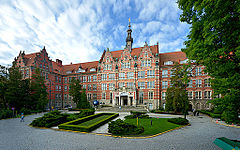 |  |
Culture
Poland's culture is closely related to its 1,000-year history. Its unique character was developed as a result of its geography, at the confluence of European cultures. With origins in Proto-Slavic culture, Polish culture has been deeply influenced over time by its links to Germanic, Latin, and Byzantine culture, as well as ongoing contact with the many other ethnic groups and minorities living in Poland.. The people of Poland have traditionally been considered hospitable to foreign artists and eager to follow popular cultural and artistic trends from other countries. In the XIX and XX centuries , Poland's focus on cultural promotion often took precedence over political and economic activity. These factors have contributed to the versatile nature of Polish art, with all its complex nuances.
Music
Poland's musicians, including famous composers such as Chopin or Penderecki and traditional folk musicians, create a lively and diverse music scene, which even recognizes its own genres of music, such as sung poetry (śpiewana poezja ) and disc pole. Poland also produced famous pianists like Arthur Rubinstein.
The origins of Polish music can be traced back as far as the 13th century; Manuscripts have been found in Stary Sącz, containing polyphonic compositions related to the Notre Dame School. Other compositions, such as the melody of Bogurodzica and Bóg się Rodzi (a coronation polonaise for the kings of Poland by an unknown composer), also date from this period, without However, the first known notable composer, Mikolaj of Radom, was born and lived in the 15th century. During the 16th century, the two main musical groups - both based in Krakow and belonging to the King and Archbishop of Wawel - led to the rapid evolution of Polish music. Composers and writers during this period include Wacław de Szamotuły, Mikolaj Zielenski and Mikołaj Gomolka. Diomedes Cato, an Italian by birth, who lived in Krakow from the age of five, became one of the most famous lutenists at the court of Sigismund III.
At the end of the 18th century, Polish classical music developed into national forms such as Polonaise. In the XIX century the most popular composers were: Józef Elsner and his students Frédéric Chopin and Ignacy Dobrzyński. Important opera composers of the time were Karol Kurpiński and Stanisław Moniuszko while the list of famous soloists and composers included Henryk Wieniawski and Juliusz Zarebski. In the middle of the 19th centuries and XX the most prominent composers were Wladyslaw Zelenski and Mieczysław Karłowicz, along with Karol Szymanowski, the latter gaining prominence before World War II, Alexandre Tansman living in Paris, but with strong connections to Poland, Witold Lutoslawski, Henryk Gorecki and Krzysztof Penderecki, and Andrzej Panufnik.
Polish traditional folk music has had a major effect on the works of many renowned Polish composers, and no more than on Frédéric Chopin, a recognized national hero of the arts, whose works involve the piano and are technically demanding, making emphasis on nuances and expressive depth. As a great composer, Chopin invented the musical form known as the instrumental ballad and made important innovations to the piano sonata, mazurka, waltz, nocturne, polonaise, study, impromptu and prelude, he was also the author of a series of polonaises. they borrowed heavily from traditional Polish folk music. It is largely thanks to him that the pieces gained great popularity across Europe during the 19th century. Today the most characteristic popular music can be heard in the cities and towns of the mountainous south, particularly in the region surrounding the winter resort town of Zakopane.
Today Poland has a very active music scene, with the genres of jazz and metal, which are very popular among the contemporary population. Polish jazz musicians like Krzysztof Komeda created a unique style, which was most famous in the 1960s and 1970s and is still popular today. Since the fall of communism, Poland has become an important location for large-scale music festivals, including the Open'er Festival, the Opole Festival, and the Sopot International Song Festival.
Visual arts
The Cracovian school of historicist painting developed by Jan Matejko produces monumental depictions of customs and important events in Polish history. Tamara de Lempicka, who specializes in art deco painting, is known to be one of the most famous painters.[citation needed]
Stanisław Witkiewicz was a supporter of realism in Polish art, its main representative being Józef Chełmoński.[citation needed] The Młoda Polska (Young Poland) was a modernist period of art, and engaged in a great deal of formal experimentation led by Jacek Malczewski (symbolism), Stanisław Wyspiański, Józef Mehoffer, and a group of Polish Impressionists. Tadeusz Makowski's art was influenced by cubism; while Władysław Strzemiński and Henryk Stażewski worked on the constructivist language. The most famous Polish sculptors include Xawery Dunikowski and Magdalena Abakanowicz.[citation needed]
Since the interwar years, Polish art and documentary photography has enjoyed worldwide recognition.[citation needed] In the 1960s, the Polish School de Carteles was formed, with Henryk Tomaszewski and Waldemar Swierzy. Some renowned art schools are the Krakow Academy of Fine Arts, the Krakow School of Art and Fashion Design, the Warsaw Academy of Fine Arts, the Szczecin Art Academy, the Poznań University of Fine Arts, and the Eugeniusz Geppert Academy of Fine Arts.
Cinema
The history of Polish cinema is as long as the history of cinematography. For decades, Poland has produced outstanding directors, film producers, cartoonists and actors who have achieved worldwide fame, especially in Hollywood. In addition, Polish inventors played an important role in the development of world cinematography and modern television. Among the most famous directors and producers, who worked in Poland and abroad are Roman Polański, Andrzej Wajda, Samuel Goldwyn, the Warner Brothers (Harry, Albert, Sam and Jack), Max Fleischer, Lee Strasberg, Agnieszka Holland and Krzysztof Kieślowski.
In the 19th century, throughout the division of Poland, numerous amateur inventors, such as Kazimierz Prószyński, were eager to build a movie projector. In 1894, Prószyński managed to create a pleograph, one of the world's first cameras. The invention, which took photographs and projected images, was built before the Lumière brothers filed their patent.He also patented an 'aeroscope', the first successful manually operated movie camera. In 1897, Jan Szczepanik obtained a British patent for his telescope. This television prototype could easily transmit images and sound, thus allowing live remote viewing. After the invention of the appropriate apparatus and technological development in the years to come, the concept of it, then impossible, became a reality.
Polish cinema developed rapidly in the interwar period. The most famous star of the silent film era was the Polish actress Pola Negri. During this time, Yiddish cinema also evolved in Poland. Yiddish films with Jewish themes, such as The Dybbuk (1937), played an important role in pre-war Polish cinematography. In 1945, the government established Film Polski, a state-owned film production and distribution organization, with director Aleksander Ford as head of the company. Ford's Knights of the Teutonic Order (1960) was seen by millions of people in the Soviet Union, Czechoslovakia and France.
In 2015, Ida by Paweł Pawlikowski won an Academy Award for Best Foreign Language Film. The Pianist (2002) by Roman Polański, is another film Polish Oscar winner.
Architecture
Polish cities and towns reflect a spectrum of European architectural styles. Romanesque architecture is represented by St. Andrew's Church in Kraków, and Wroclaw Cathedral is characteristic of the brick Gothic style found in Poland. The richly decorated penthouses and arcadeloggias are the common elements of Polish Renaissance architecture, as is evident in the Poznan City Hall. For some time, the late Renaissance style known as Mannerism, most notably in the Royal Castle in Warsaw, coexisted with the early Baroque style, typified in the Church of Saints Peter and Paul in Krakow.
History has not been kind to Poland's architectural monuments. Nonetheless, several ancient structures have survived: castles, churches, and stately homes, often unique in a regional or European context. Some of them have been painstakingly restored, such as the Wawel Castle, or completely rebuilt, including Gdansk's Old Town and Warsaw's Old Town. Warsaw now has many modern buildings and skyscrapers in the city center, where some once there were the conventillos.
Gdansk's architecture is mainly of the Hanseatic variety, a Gothic style common among old trading cities along the Baltic Sea and in the northern part of Central Europe. Wroclaw's architectural style is primarily representative of German architecture, as it was for centuries located within the Holy Roman Empire. The center of Kazimierz Dolny is a fine example of a well-preserved medieval town. The former capital of Poland, Kraków, is among the best-preserved Gothic and Renaissance urban complexes in Europe.
The second half of the XVII century is marked by Baroque architecture. The side towers, like those of the Branicki Palace in Bialystok, are typical of the Polish Baroque. The Silesian Baroque classic is represented by the University of Wroclaw. The profuse decorations of the Wilanów Palace are characteristic of the Rococo style. The center of Polish classicism was Warsaw under the rule of the last Polish king Stanislaus II Poniatowski. Łazienki Palace is the most remarkable example of Polish neoclassical architecture. Lublin Castle represents the Gothic Revival style of architecture, while Moszna Castle is an example of eclecticism.
Literature
During the Middle Ages, most Polish writers and scholars (for example, Jan Długosz) wrote only in Latin, the common language of European letters. This tradition was broken by Jan Kochanowski, who became the first Polish author to write most of his works in Polish. Poland was the birthplace of great authors during the 19th and XX, such as Adam Mickiewicz, Henryk Sienkiewicz, Bolesław Prus, Wladyslaw Reymont, Witold Gombrowicz and Czeslaw Milosz. Joseph Conrad (1857-1924), son of the Polish playwright and poet Apollo Korzeniowski, gained worldwide fame by adapting English as a literary language in his novels. Two Polish prose writers have won the Nobel Prize for Literature: Henryk Sienkiewicz and Wladyslaw Reymont.
Among the best-known Polish poets are the "three bards" ("trzej wieszcze"), a group made up of Mickiewicz, Krasinski and Słowacki, three representatives of the country's romantic literature. The Polish word "wieszcz" means prophet or soothsayer. Poland has had two Nobel Prize-winning poets: Czeslaw Milosz and Wisława Szymborska.
In 2019, Polish author Olga Tokarczuk was awarded the Nobel Prize in Literature for the year 2018.
Gastronomy
The cuisine of Poland is a mixture of cuisines of West Slavic and German origin, as well as culinary traditions typical of the area. It is closely related to Slavic cuisines in the use of oats and other cereals, but has been influenced by Turkish, German, Hungarian, Jewish, Armenian, French or colonial cuisines of the past. It can be said with great generality that Polish cuisine is rich, hearty and relatively high in fat. Poles are famous for the generosity they devote to meal periods. The best known product that originated in Poland is the bagel.
During the Middle Ages the cuisine of Poland was very heavily seasoned with spices. At that time, two of the main ingredients were meat (beef) and cereal. The territory of present-day Poland was densely populated with trees, and it is for this reason that mushrooms, forest fruits, nuts and honey were used very frequently in the cuisine of that time. Thanks to the proximity to Eastern countries, the price of some spices such as juniper, black pepper and nutmeg had lower prices than in the rest of Europe, and this was the reason that the use of spices became popular in some Polish dishes. Another purpose was the need to neutralize bad odors from not-so-perfectly preserved foods. The most popular drink is beer, including very slightly fermented podpiwek, and mead. In the 16th century the upper classes began to import wines from Hungary and Silesia. Some distilled spirits such as vodka, which were beginning to be popular in Europe, were already common drinks among the lower classes.
With the accession to the throne of Queen Bona Sforza, the second wife of Sigismund I of Poland in 1518, countless Italian and French cuisines were brought to Poland. In this simple way, some of the vegetables classically used in these cuisines began to be seen more and more in Polish cuisine, such as lettuce, leeks, celery and cabbage. Even today, the names of these vegetables such as leeks, carrots and celery are known in Polish as wloszczyzna, referring to Wlochy which is the Polish name for Italy.
A typical meal consists of three courses, usually starting with a soup, such as żurek (sour-tasting flour soup), barszcz (beetroot soup), or tomato soup, followed perhaps by an appetizer salmon or herring (prepared in cream, oil or vinegar). Other popular appetizers are made with different meats, vegetables or fish in aspic (jelly). For the main course you can try the national dish called bigos (sauerkraut or sour fermented cabbage with pieces of meat and sausages) or schnitzel (Polish schabowy, breaded pork chop). Finishing with a kind of sweet note like an ice cream, or even better if you are lucky a piece of makowiec, which is a kind of homemade poppy seed cake, or napoleonka a type of yeast cake.
Other Polish specialties include golonka (pork knuckle), goulash (boiled pieces of meat with vegetables), kołduny (a kind of boiled meat-filled dumpling that accompanies soups), pulpety (meatballs from Italy), zrazy (slices of beef), salceson (a kind of smoked sausage), tripe, sausage, pierogi (dumplings), and bagel (bread product).
Sports
Many sports are popular in Poland. Volleyball and soccer are the most popular in the country, with a rich history of international competition. Athletics, ski jumping, basketball, boxing, fencing, handball, ice hockey, swimming, and weightlifting, among others, are also popular.
The golden age of soccer in Poland occurred throughout the 1970s and continued until the early 1980s when the Polish national soccer team achieved its best results, finishing in 3rd place.er place in the Soccer World Cup in the 1974 and 1982 editions. In addition, the team won the gold medal in soccer in the 1972 Munich Olympic Games, also getting the silver medals in the 1976 and 1992 editions. Poland, along with Ukraine, hosted Euro 2012. The captain of the Polish team is Robert Lewandowski, a player for Fútbol Club Barcelona
Mariusz Pudzianowski is a highly successful strength athlete and has won more titles in the World's Strongest Man competition than any other competitor in the world, winning the event in 2008 for the fifth time. The first Polish Formula 1 driver, Robert Kubica, has brought great expectation. Poland has made a distinctive mark on the racing motorcycle road thanks to Tomasz Gollob, a highly successful Polish rider. The Polish National Speedway Team is one of the great teams when it comes to speedway practice and has been very successful in various competitions. One of the most important motorcycle circuits in Poland is that of Poznan. Many Poles have made significant achievements in mountaineering, particularly in the Himalayas (Eight Thousand). The most famous Polish climbers are Jerzy Kukuczka, Krzysztof Wielicki, Kinga Baranowska and Wanda Rutkiewicz.
The Polish mountains are an ideal place for hiking, climbing, skiing and mountain biking, attracting millions of tourists every year from all over the world. The Baltic Sea, as well as some beaches and spas, are popular places for fishing, boating, kayaking, and a wide range of other water sports.
In cycling, Michał Kwiatkowski, road world champion in Ponferrada 2014, stands out.
Mariusz Wlazły, Paweł Zagumny, Michał Winiarski and Bartosz Kurek Volleyball current celebrity.
In tennis, Iga Swiatek, a member of the top 10 and Poland's first Grand Slam singles champion after her victory at Roland Garros 2020, currently stands out.
Fashion
Fashion has always been an important aspect of Poland and its national identity. Poland is one of the most fashionable and best-dressed countries in the world. Although the Polish fashion industry is not as famous compared to the industries in France and Italy, it still contributed to global trends and dressing habits. In addition, a number of Polish designers and stylists left a lasting legacy of beauty and cosmetic inventions, which are still in use today.
Throughout history, clothing styles in Poland often varied due to foreign influence, especially from neighboring countries and the Middle East. Due to its geographical position, Poland was metaphorically referred to as a trade route linking Western Europe with the Ottoman Empire, the Crimean Khanate, and Persia. This allowed the Poles to absorb various habits, which were present in the Middle East at the time. The nobility and upper-class magnates wore attire somewhat resembling oriental styles. Outfits included a Żupan, Delia, Kontusz and a type of sword called Karabela, brought by Armenian traders. Wealthy Polish aristocrats also held Tatars and Janissaries captive at their courts; This affected the national dress. The extensive multiculturalism present in Poland-Lithuania developed the ideology of "Sarmatism".
Polish national dress, as well as fashion and etiquette from Poland, also reached the royal court at Versailles in the 18th century . Some French dresses inspired by Polish costumes were called à la polonaise, which means "Polish style". The most famous example is the robe a la polonaise or simply polonaise, a women's garment with a loosely draped skirt. Another notable example is the Witzchoura, a long cloak with a collar and hood, possibly introduced by the Napoleon's Polish mistress, Marie Walewska.
Established in 1999, Reserved retail store is the most successful clothing store chain in Poland, operating more than 1,700 retail stores in 19 countries. In 2016 it was announced that Reserved will move into a former BHS store in Oxford Street in London, one of the most prestigious and busiest shopping malls in Europe.
At the beginning of the 20th century, the underdeveloped fashion and cosmetics industry in Congress Poland was heavily dominated by western styles, mainly from the United Kingdom and the United States. This inspired Polish beautician Maksymilian Faktorowicz to seek employment abroad and create a line of cosmetics called Max Factor in California. In 1920, Faktorowicz invented the joint word "makeup" based on the verb phrase 'make up', now used as an alternative for 'cosmetics'. Faktorowicz also became famous inventing modern eyelash extensions and providing services to Hollywood artists of the time such as Gloria Swanson, Pola Negri, Bette Davis, Joan Crawford and Judy Garland.
Another Polish woman who contributed to the development of cosmetics was Helena Rubinstein, founder of the Helena Rubinstein Incorporated Cosmetics Company, which made her one of the richest women in the world, and was bought by L'Oréal. Rubinstein's most controversial quote was "There are no ugly women, only lazy ones".
Inglot Cosmetics, founded in 1983, is Poland's largest manufacturer and retailer of beauty products, selling in 700 locations worldwide, including salons in New York City, London, Milan, Dubai and Las Vegas.
Parties
| Date | Name in Spanish | Local name |
|---|---|---|
| 1 January | New Year | Nowy Rok |
| 6 January | Three Wise Men | Trzech Króli |
| March or April | Easter | Wielkanoc |
| 1 May | Workers' Day | Święto Pracy |
| 2 May | National Flag Day | Święto Flagi Rzeczypospolitej |
| 3 May | Constitutional Day | Święto Konstytucji |
| June | Corpus Christi | Boże Ciało |
| 15 August | Asunción y Día de Fuerzas Armadas | Wniebowzięcie i Dzień Wojska Polskiego |
| 31 August | Day of Solidarity and Freedom | Dzień Solidarności i Wolności |
| 1 November | Day of All Saints | Wszystkich Świętych |
| 11 November | Independence Day | Święto Niepodległości |
| 24 December | Christmas Eve | Wigilia |
| 25 December | Christmas Day | Boże Narodzenie |
| 26 December | Christmas | Drugi dzień świąt Bożego Narodzenia |
Contenido relacionado
Nolita
Guatemala Demographics
Map conic projection
